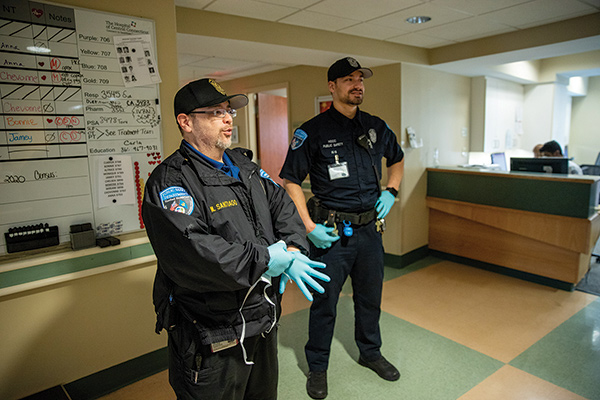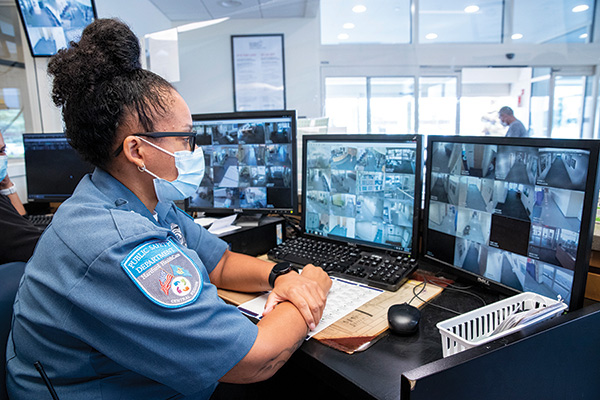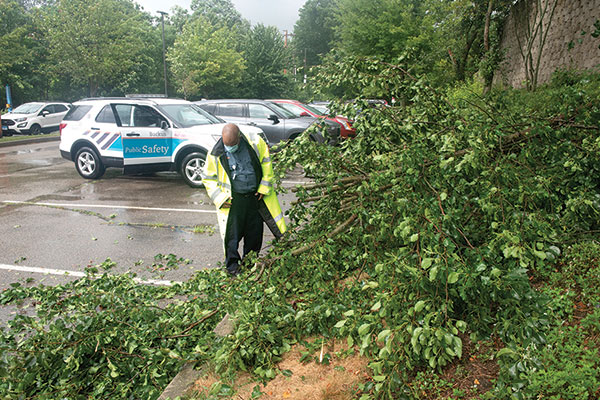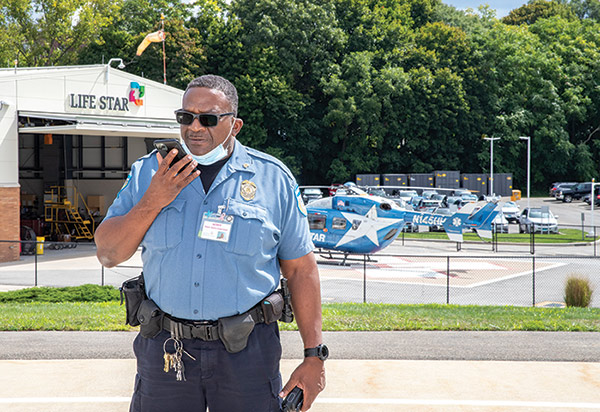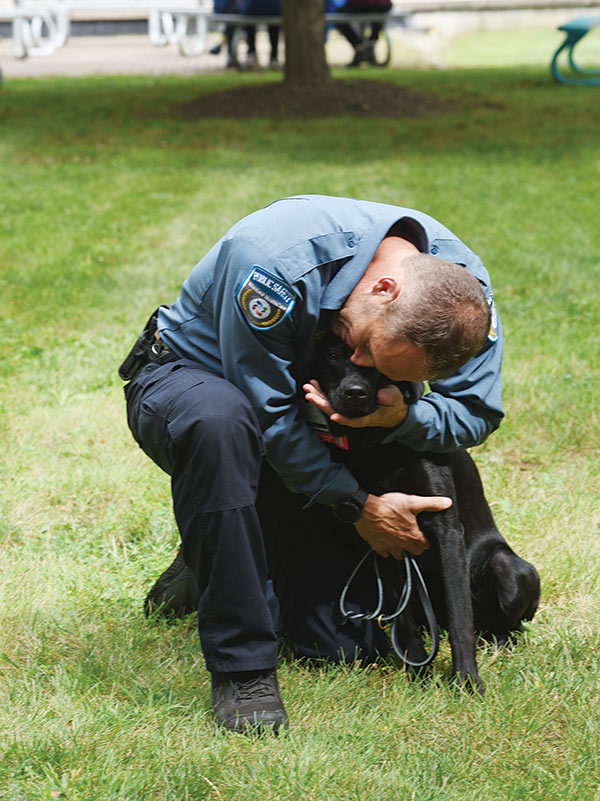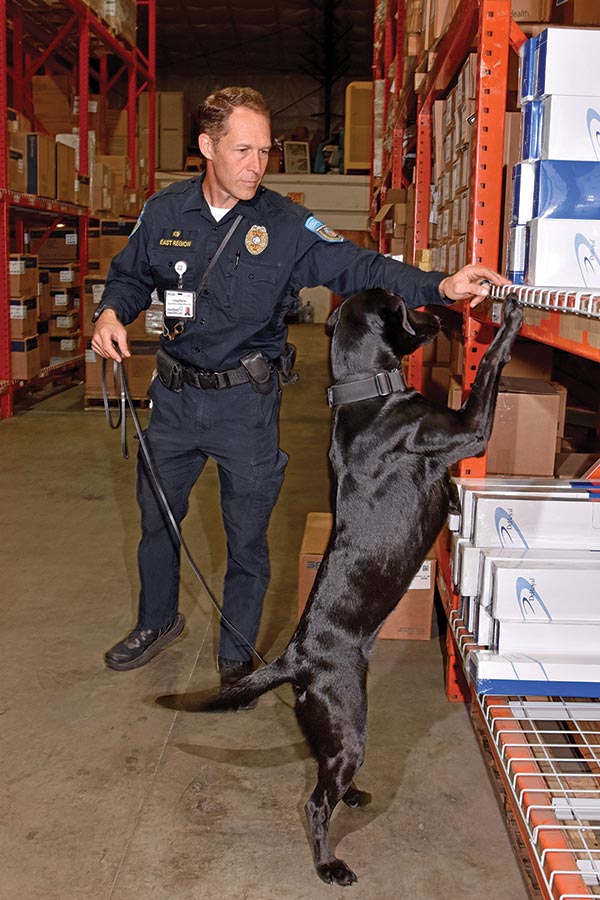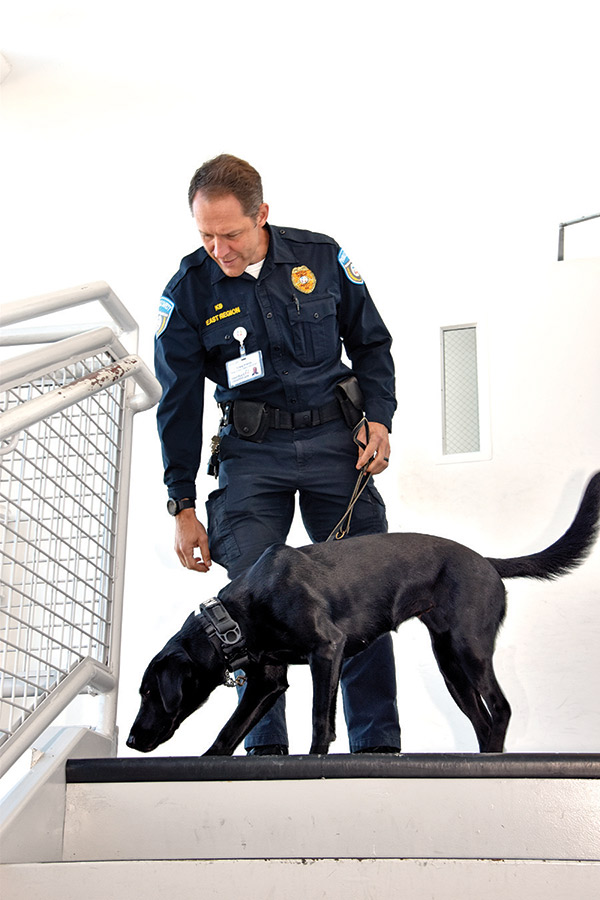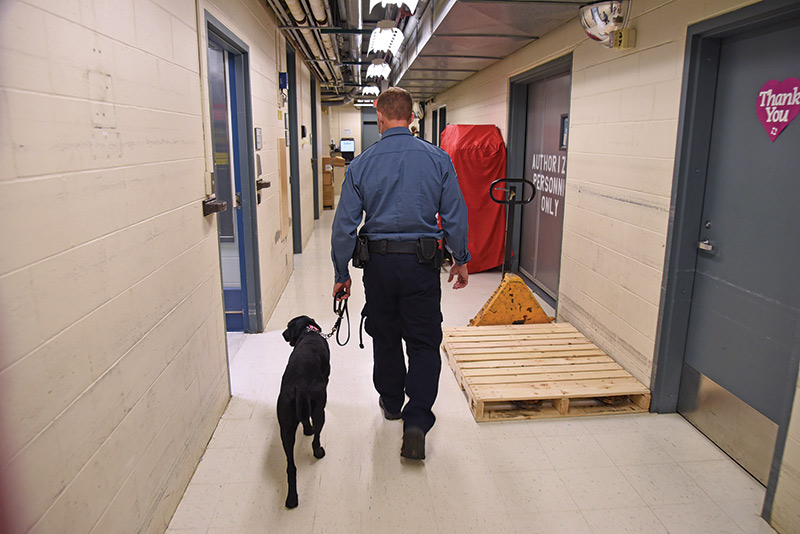In a world that seems increasingly uncivilized and unsafe, the public safety team at Hartford HealthCare launched a movement to streamline and reinforce efforts to create safe environments for colleagues and people coming in for care.
HHC Senior System Director of Public Safety and Emergency Management Patrick Turek and his team are reinforcing the sense of security by expanding coverage from hospital-specific crewsto a system-wide presence that covers off-site locations and by sharing knowledge that empowers colleagues to be safer and more prepared. Their slogan is “Empowering Expertise, Safer and More Prepared.”
“We have been rallying the organization to transform and improve colleagues’ safety and security experiences,” Turek says, adding that healthcare workers “are 20% more likely than other professions to be subject to workplace violence.”
Areas of focus
In revamping public safety at HHC, the focus has been on five areas:
- Service excellence and integration. Public safety officers — many of whom have law enforcement, corrections or military backgrounds — are being more engaged in their work here, which improves the customer service they provide.
- Physical security. The team examined how to create the safest environments for HHC colleagues wherever they work.
- Empower colleagues. Sessions such as de-escalation training can help colleagues feel safer and be more aware of their surroundings.
- Workplace violence protection. Turek calls this“one of the largest challenges in healthcare.”
- Enhance protection to areas of high risk. This can range from avoiding theft in the pharmacy to thwarting infant abduction to preventing violent outbursts in an emergency department.
“It’s about pausing, resetting and de-escalating. That’s what we’re doing 99% of the time.”
The work has expanded protection to every HHC location, Turek says.
“All 29,000 colleagues should be afforded appropriate security measures in their workplace,” he notes. “Some areas, like larger medical practices and physical therapy offices, haven’t had any security and called local law enforcement for help. We’re pushing the limits to ensure public safety is a new security advocate for them.”
And, while public safety can help, Turek notes that each colleague must also contribute to this effort especially by being in the moment, avoiding using their cell phones in parking lots, looking out for suspicious activity, or being aware of concerning behaviors in patients, customers, visitors and even colleagues.
Challenge accepted
President and CEO Jeffrey Flaks and members of his cabinet challenged the public safety team to “think about anything that would keep our people safe,” Turek says. The timing was uncanny, coming around the time of the Middlesex Hospital safety breach and mall shooting in San Bernardino, CA.
“We started with a sound risk assessment, a thoughtful and planned approach,” Turek says.
His team, which maintains bases at each hospital,was expanded with new staff and integrated to become more united instead of operating in silos.
“We automatically get more resources when we pull together, and we’re pulling from a deeper bench,” Turek says.
Coverage was also added to Hartford HealthCare Medical Group and Hartford HealthCare at Home locations.
“In the more acute care environments, you will see more security and more services. You’ll also see the officers doing intermittent rounds so people can get used to seeing them,” Turek explains.
“It’s been a wholesale change in services, adding pre- and post-acute care areas, where we will have a full-time officer rounding at the practices. We can’t be everywhere all the time, but when requested, we will be sure to respond.”
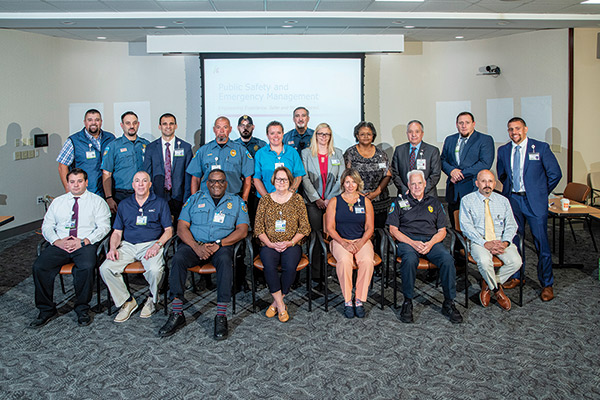
Shoring up support
Expanding his team is an ongoing task for Turek, as is working with officers to strengthen the compassion and understanding anyone working in healthcare should display.
“We all have to remember that these are people in times of great need and we must rise above situations. They are hurting. It’s not personal,” he stresses. “It’s about pausing, resetting and de-escalating. That’s what we’re doing 99% of the time.”
HHC values provide the perfect frame for these trainings, he adds.
“We must be kind to people. We must do the right thing. We need to recall these values during every interaction,” Turek says.
Looking ahead
The new HHC headquarters on Pearl Street in Hartford poses a different security challenge for the expanding team due to largely glass first and second floors and the presence of system leadership. Turek expects the team to be called upon to respond to our ever-changing environments and world.
Even so, he says his team is ready to reinforce the sense of security every colleague and patient deserves when they come to an HHC location.
“We are determined to build people’s confidence in security,” Turek says.
By the numbers
- 270 Approximate number of full- and part-time public safety officers
- 5 Regional public safety directors
- 1-3 Managers per region
- 3 K-9 handlers
- 1 System-wide Public Safety and Emergency Management Council
October 29, 2022, third shift
Take a look at one overnight shift to see the variety of things public safety officers are called upon to do.
STAFF LEVELS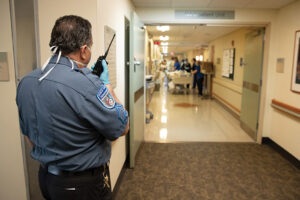
- 5 Backus Hospital (BH)
- 3 Charlotte Hungerford Hospital (CHH)
- 16 Hartford Hospital (HH)
- 8 The Hospital of Central Connecticut (HOCC)
- 3 MidState Medical Center (MSMC)
- 5 St. Vincent’s Medical Center (SVMC)
- 3 Windham Hospital (WH)
11 PM → SHIFT STARTS
11:34 PM → Tirus Denny-Smalls escorts patient from SVMC ED to Behavioral Health Unit.
11:41 PM → A patient is discharged from the HH ED and refuses to leave. Officers Jose Rodriguez and Raheem Martinez respond and escort the patient off the property without further issue.
12:30 AM → CHH officers respond to the ED to help with a drunk patient coming in.
1 AM → MSMC officers Marquilous Carter, Joe Demichele and Carmelo Roman are dispatched to the ambulance bay to help with an incoming patient who is combative.
2:25 AM → BH officer Kevin Ledoux searches a room in the psychiatric pod of the emergency room.
2:28 AM → HOCC officer Joel Rosado responds to medical rapid response for security presence.
2:30 AM → HH safety officers Kyle Lariviere and Martinez respond to the ED to meet a gunshot wound victim who drove himself to the hospital for care. Hartford police also respond.
3:13 AM → Officers Lariviere and Martinez are dispatched to HH Bliss 9 to help staff with a patient attempting to leave. The officers successfully verbally deescalate the patient.
3:15 AM → WH officer Bob Bardelli patrols the outside of the hospital with no issues.
4:37 AM → An intoxicated man almost drives himself into the ambulance bay doors at the HH ED, and tries to get in through the bay. Four officers — Lariviere, Breanna Bell, Martinez and Rodriguez –—respond to the area but the subject drives off. The police are notified.
4:40 AM → Officers report to the CHH Crisis Unit for a verbal de-escalation.
5:05 AM → MSMC officers Carter, Demichele and Roman respond to help medical staff medicate an uncooperative patient in the ED.
5:40 AM → HOCC officers Marcin Adamkiewicz and Alejandro Gonzalez remove an unwanted discharged patient from the property.
6:06 AM → Jarrett Heyward at SVMC responds to nuclear medicine to open a door.
6:14 AM → BH officers Jeff Rivera, Steve Duperval, Ed Ledoux and Kevin Ledoux respond to an agitated patient in the ambulance bay of the Emergency Department.
Going to Work Each Day With His Best Friend
By Bonnie Tormay

Craig Plante and Remi became a team in August 2021 and have been working side by side at Backus Hospital ever since. Plante, a retired corrections captain, started working as a public safety officer for Hartford HealthCare in 2018 as a second career.
What kind of training do the dogs receive?
Remi was training to work for Homeland Security,but during the height of COVID, her training was put on hold because travel had decreased.
Two years later, I was paired with Remi and that’s when her training continued. When she first came home, we had to get to know one another. I brought her to work so she could get used to the sites she would be working, and she received training including leash obedience, getting familiarized with different surfaces, and on and off elevators.
In addition, Remi completed a seven-week academy involving explosive detecting, recognizing odors, handling, searches, obedience and exercise. Training doesn’t end there. She must complete training at least once a month.
Does Remi have a uniform?
Remi is a smaller Labrador weighing in at 55 pounds. I found that anything I put on her hindered her ability to move around and was more distracting. She doesn’t have a particular uniform, but wears a dog collar with her name on it.
What’s her personality like?
Remi is extremely friendly and loves belly rubs. She is full of energy and acts like a puppy when not on the job. I describe her as having a split personality because when it’s time to work there is a definite behavior change. Her nose turns on and she turns into a hunting dog, hunting for odors.
How long does she work?
Overall, we both work a regular schedule, Monday through Friday. The position requires you to be flexible and sometimes we work earlier, later or on weekends for events.
What is the most important moment you’ve experienced on the job?
In general, it would be being at the right place at the right time. For example, people often need to be seen in the Emergency Department and don’t want to go. Once they see Remi, it starts a conversation about how much they love dogs. We end up walking in together and they can get the help they need. This has happened several times.
What does Remi do when not working?
At the end of the work day, Remi goes home with me. I also have a 9-year-old Lab and they enjoy running around the yard and playing together.
What will happen to Remi when they retire?
The capability of the dog determines when they are ready to retire. Work life for each K9is different based on their breed and type of work they do. Other things to consider is their physical health and whether or not their skills are diminishing. Remi’s work life should bring her to around eight to 10 years old. We track everything she does every day, including where and how she is working, what she is doing, trainings and how she reacts to odors.
What do you like the most about working with Remi?
I get to go to work every day with my best friend— it couldn’t be any better. I appreciate her partnership. I like the opportunities the K9 team has given me personally and professionally. I go to work with a purpose, and really enjoy meeting colleagues, patients and visitors.
What’s the most challenging?
The most challenging thing was setting ground rules. At first, no one could pet her while she was working because she needed to understand when we were working and not working. When I was able to ease up and let people meet her and be more personable, it was great, except everyone wants to give her a treat, which is now the hardest part of my day.
Anything else you’d like to share?
We are approachable. Please say hi!
Reports from the Front Lines
The public safety officers across the system are the ones on the front lines when any sort of disturbance or disaster occurs — car fires in the parking lot, skirmishes in the emergency department or unruly patients needing an escort. We asked the regional security managers to share memorable moments from the past year.
Backus Hospital
On August 8, 2022, at approximately 6 p.m., Backus public safety officer Spencer Way radioed for a non-patient medical response at the Emergency Department entrance. There, a 39-year-old woman had walked in expressing symptoms of pain, and took a seat on a bench just inside the doors to the ED.
Spencer retrieved a wheelchair at this time and radioed the operator to announce a non-patient medical response. This summoned the public safety manager, who arrived about the same time as medical staff from the Emergency Department and the Labor and Delivery Unit. The patient was actively giving birth. Spencer directed foot traffic around the scene while medical staff cared for the patient and her baby’s medical needs.
—Submitted by Gen Boas
Charlotte Hungerford Hospital
On Tuesday, April 26, 2022, Carol Loveland was working the switchboard on third shift when a distraught man called asking “how to kill myself.” Carol’s training and instincts immediately kicked in and, instead of disregarding the call as a prank, she tried to get some patient information from the man before correctly transferring the call to the Emergency Department Crisis Unit.
Based on information from the Torrington Police Department, the caller hung up and the Crisis Unit staff unsuccessfully attempted to call him back. They then contacted Torrington EMS for a welfare check. Contact was made with the man and he was transported to the emergency room and the Crisis Unit for further care.
Hospital colleagues and police told Carol that her quick thinking and actions contributed to saving the man’s life. Carol’s actions underscore how switch board and public safety teams are committed to their role in the hospital and community, and don’t take their duties lightly.
—Submitted by Brian Ohler
Hartford Hospital
In the morning of August 8, 2022, public safety managers Jeff Cozza and Joe Szymanski were made aware of a bomb threat called into the hospital’s switchboard. The caller twice repeated, “There’s a bomb in the hospital.” When the operator asked if the caller was looking for a patient, he stated, “There’s a military bomb in the hospital. It’s gonna explode.” The operator transferred the call to the security dispatch center, where the man repeated the comment about a bomb.
After calling the Hartford Police Department, Jeff went to the Emergency Department to meet with officers and Joe notified the emergency management team. The police identified the caller as someone who was well known to them, as well as to public safety and emergency department staff at the hospital. Once we realized it was someone with a history of making verbal threats, public safety scaled back response and asked emergency management to share the man’s picture with guest relations staff in the lobbies. No one had seen him that day.
Hartford police took a statement from the operator who spoke with the man. He was arrested that night on felony threatening charges. This is an excellent example of the public safety team treating every threat against the hospital, colleagues, patients and visitors seriously.
—Submitted by Peter Fraser
The Hospital of Central Connecticut
Officer Cory Ouellette demonstrated several H3W Behaviors and HHC Core Values when a stabbing victim entered the Emergency Department.Without hesitation, he left his post and began helping the victim, placing a trash can below the bleeding arm to control the contamination zone and minimize decontamination time. This saved countless minutes for environmental service.
Officer Ouellette quickly applied a tourniquet to the victim’s arm, effectively controlling the bleeding and allowing nursing staff to properly assess the wound. Within minutes, the patient was rushed into emergency surgery. Later, two trauma surgeons recognized that Officer Ouellette’s quick thinking meant the victim needed no blood. With the American Red Cross declaring a “National Blood Crisis” due to a 62% drop in blood donations, his actions may have indirectly saved an unknown life.
—Submitted by Steve Albert
MidState Medical Center
During the early morning hours of June 3, 2022,public safety officers Carmelo Roman and Marquilous Carter were switching off at the Emergency Department post, and Roman told Carter a man had been in the restroom for several minutes. Carter conducted a welfare check and found him in the bathroom stall. When he still hadn’t left the restroom 20 minutes later, Carter sensed something was amiss and went to check again. This time, he found the man unconscious on the floor with drug paraphernalia on the ground. Carter immediately asked the switchboard operator to dispatch medical assistance. Unable to get the man to respond, he broke down the stall door. Medical staff revived the man and brought him to the ED for treatment. Carter’s attentiveness helped prevent what could have been a much different outcome for this man.
—Submitted by Erik Copeland
St. Vincent’s Medical Center
A Fairfield police officer was in the Emergency Department on Thursday evening, October 13,2022, accompanying a prisoner with a stomach ailment that required him to use the restroom several times. The police officer had removed the handcuffs, allowing the prisoner to use the restroom under supervision and he was then re-secured.
This happened two times without incident, but the third time the prisoner suddenly attempted to run away. As he ran toward the exit doors, chased by the police officer, public safety officer Tirus Denny-Smalls physically blocked him, preventing the escape. The prisoner continued to struggle and resist being handcuffed. Thanks to the great team-work, the prisoner was successfully brought under control and secured in handcuffs with no serious injuries to anyone.
Although this was a very fast-moving and violent incident, Tirus reacted decisively and placed himself in potential danger to safeguard others in the Emergency Department and prevent the prisoner from escaping. That kind of action is the true essence of what it means to be a public safety officer, and drew compliments from the Fairfield police chief, who expressed his appreciation for the assistance in making sure a potentially dangerous prisoner did not escape.
—Submitted by Ed Shea
Windham Hospital
Windham public safety officer Jose Velez finished working a day shift in November 2022, clocked out and began his drive home. Leaving the hospital parking lot, he saw a disabled elderly woman walking toward the hospital. As she stepped off the curb, she fell onto the roadway. Jose immediately pulled over, parking his vehicle in a position to protect the woman.
The woman was not badly injured and stood on her own, explaining that she wanted to be seen in the Emergency Department. She refused an ambulance, and wanted to walk. Jose properly parked his vehicle and walked with the woman until she got safely into the ED.
Jose never reported his actions. Another Windham colleague watched the incident and notified public safety leaders, saying how proud she was that Jose, in his uniform, had displayed every leadership behavior for all to see.
—Submitted by Gen Boas
Ingraining Care, Respect in Daily Work Lives
In 2022, the system launched pilots of an organizational culture change called Mutual Care Mutual Respect (MCMR) at Backus, Charlotte Hungerford and Hartford hospitals. The program, developed and deployed by members of the human experience team, was created to address trends of incivility and egregious patient conduct toward healthcare workers and underscore the need to take organizational responsibility to support a culture of mutual respect. Signage at the hospitals announced that we will not tolerate: discrimination of any kind; aggressive or violent behavior and language; intentional disruption of the care environment; sexual harassment; weapons; photography or videography within the facilities; and audio recording without the consent of all parties. We asked people at the hospitals what they thought about MCMR. Find out more about Mutual Care Mutual Respect at www.hartfordhealthcare.org/respect.

Jeanna Zavistoski
Paramedic, Plainfield Emergency Care Center
Last week, we had 27 patients on our tracker in a 12-room department. We were triaging folks to see who needed to come in sooner when a gentleman came through the door screaming that he was here first and needed to be seen first. He used a lot of not nice words, saying we were taking patients before him. I let him know the triage process was set up to find out who was more ill, and they should come in before him if they were more emergent that he was. He wasn’t taking that as an answer and I says, “Sir, yelling at me is not going to get you in faster. There are patients here who are more ill than you.” He did simmer down some and I think the explanation of what triage is and how we work through the process made a big difference in how he viewed his care would go.

Annie MacAulay, MSN
Director of emergency services, Charlotte Hungerford Hospital
I believe the Mutual Care, Mutual Respect initiative shows support and backing from leadership and the system. This shows that we simply won’t tolerate displays of violence, disrespect or inappropriate behavior as we care for our community. Staff understand that we are now encouraged to be transparent and share with patients or family that their care is a partnership in in which we all have responsibilities. With the increase in healthcare violence, this is a long-awaited first step of confirmation to the team that we can provide care in a safe and secure environment of healing, excellence and trust.
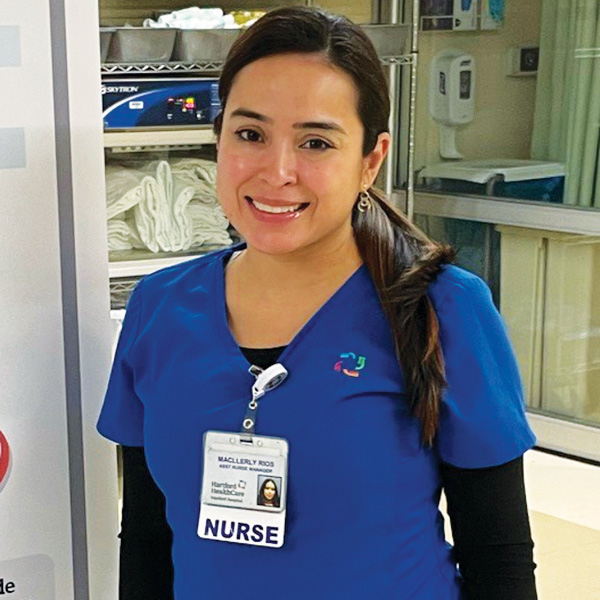
Macllerly Rios, BSN
Assistant nursing manager, Hartford Hospital Emergency Department
Supporting health and wellness is everyone’s responsibility. When we all work together — including patients, families, loved ones and the care team— patients have the best outcomes. Mutual Care, Mutual Respect helps us all understand and really puts into perspective what is most important: a safe, healing environment for our patients and for all. Since this was rolled out at Hartford, we have seen improvement in the interactions between our visitors and care team. In particular, our welcome ambassadors have reported a decrease in the amount of verbal escalations at the greeter desk.

Anesta Williams
Nurse, Backus Hospital
The relationship between healthcare organizations and their customers is more fraught than ever. Healthcare workers are encountering incivility and egregious patient conduct. This creates distractions and stress, which may impact our ability to provide quality, equitable care to all who come to Hartford HealthCare. As an organization, we have a responsibility to support a culture of mutual respect in order to support access, affordability, equity and excellence. HHC is embarking on an organizational culture change to support the health and wellness of our customers and colleagues by fostering a culture of Mutual Care and Mutual Respect (MCMR). With H3W Leadership behaviors and HHC values as a foundation, MCMR starts with focusing on the work we need to do with each other to create a safe and supportive environment in which to work. Our alignment with these expectations creates a strong foundation for us to address discrimination, harassment, violence and abusive language from our patients, customers and colleagues.
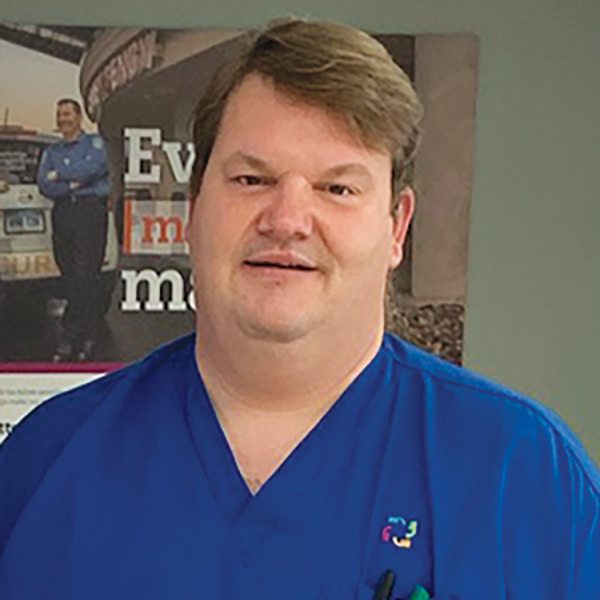
Brian Ohler
Regional director of public safety operations and emergency management Charlotte Hungerford Hospital
If we are going to provide a care setting that is safe, secure and inclusive, there must be an unwavering commitment on behalf of staff, patients and caregivers to treat each other with kindness and respect. It is one thing to verbalize this intent, but action is also needed to codify the efforts that are being done in order to ensure that trust, respect, civility and cooperation remain at the forefront of every telephone conversation, ambulatory visit and inpatient stay. Mutual Care, Mutual Respect is a revolutionary program that will act as a necessary building block, planted firmly in a foundation, to help us in our overall mission to eradicate workplace violence and put an end to the upward trend of verbal and physical assaults on our healthcare colleagues.


